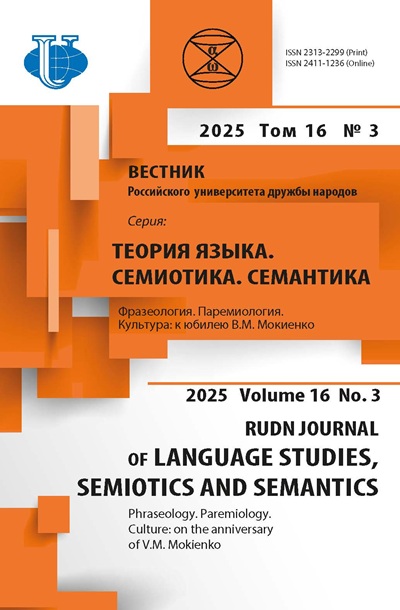Прецедентный топоним как политический символ
- Авторы: Бугаева И.В.1
-
Учреждения:
- Московский государственный психолого-педагогический университет
- Выпуск: Том 9, № 1 (2018)
- Страницы: 124-135
- Раздел: ПОЛИТИЧЕСКАЯ ЛИНГВИСТИКА
- URL: https://journals.rudn.ru/semiotics-semantics/article/view/18272
- DOI: https://doi.org/10.22363/2313-2299-2018-9-1-124-135
- ID: 18272
Цитировать
Полный текст
Аннотация
Прецедентные топонимы в политическом дискурсе часто выступают как символы государственной власти: Кремль, Белый дом, Wall Street, Берлин, Лондон и т.д. Прецедентные топонимы в политическом дискурсе выступают как символы государственной власти. Анализу значений прецедентного топонима Красная площадь посвящена данная статья. Материалом исследования послужила сплошная выборка примеров из Национального корпуса русского языка, фрагменты из художественной литературы, устной речи и интернет-источников. С помощью семантического анализа, направленного на определение основной семы, определялось значение топонима в конкретном контексте. Полученные значения классифицировались. В результате выявлено 16 семантических значений прецедентного топонима Красная площадь. В русской языковой картине мира у топонима Красная площадь отмечаются денотативное, коннотативное, прецедентное значения, дополняемые уникальным ассоциативным фоном, восприятие и оценка которых различается в группах носителей и не носителей русского языка. У данного топонима постепенно сформировался образ, который стал маркированным знаком мировой культуры с собственной системой представлений и ассоциаций. Для изучающих русский язык как иностранный ряд известных топонимов, относящихся к группе прецедентных, например, Москва, Кремль, Красная площадь, имеют только политическое значение как символы России и государственной власти. Формируя у студентов-иностранцев культурологические компетенции, целесообразно раскрывать весь спектр значений прецедентного топонима.
Об авторах
Ирина Владимировна Бугаева
Московский государственный психолого-педагогический университет
Автор, ответственный за переписку.
Email: bugaevaiv@mail.ru
SPIN-код: 4250-2339
доктор филологических наук, профессор, кафедра лингводидактики и межкультурной коммуникации факультета иностранных языков Московского государственного психолого-педагогического факультета
ул. Сретенка, 29, г. Москва, Россия, 127051Список литературы
- Баталов А.Л., Беляев Л.А. Сакральное пространство средневековой Москвы. М.: Феория. Дизайн. Информация. Картография, 2010.
- Березович Е.Л. К построению комплексной модели топонимической семантики // Известия Уральского госун-та. 2001. № 20. С. 9-15.
- Болотина К.Э. Прецедентные феномены в языковой картине мира квебекцев // Вестник РУДН. Серия: Лингвистика. 2016. Т. 20. № 2. С. 61-76.
- Большой энциклопедический словарь. М.: Советская энциклопедия, 1980.
- Бугаева И.В. Красная площадь в городском пространстве и русской ментальности // Ономастика Поволжья: материалы XVI Международной научной конференции, посвященной 50-летнему юбилею первой Поволжской ономастической конференции и памяти ее организатора В.А. Никонова (Ульяновск, 20-23 сентября 2017 г.) / под ред. С.В. Рябушкиной, В.И. Супруна, Е.В. Захаровой, Е.Ф. Галушко. В 2 т. Т. 1. Ульяновск: ФГБОУ ВО «УлГПУ им. И.Н. Ульянова», 2017. C. 17-23.
- Бугаева И.В. Фоновая семантика топонимов // Вестник Тамбовского университета. Серия: Гуманитарные науки. 2007. № 4 (48). С. 13-17.
- Васильев А.Д. Некоторые прецедентные топонимы в языковом сознании красноярцев // Вестник Красноярского гос. пед. ун-та. 2014. № 3 (29). С. 164-166.
- Васильева С.П. Русская топонимика Приенисейской Сибири: картина мира: дисс.. д. филол. н. Красноярск, 2006.
- Воробьев В.В. Лингвокультурология (теория и методы). М.: Изд-во РУДН, 1997.
- Голомидова М.В. Искусственная номинация в русской ономастике: Монография. Екатеринбург: Урал. гос. пед. ун-т, 1998.
- Горбаневский М.В. Русская городская топонимия: Проблема историко-культурного изучения и современного лексикографического описания: дисс.. д. филол. н. М., 1994.
- Гудков Д.Б. Прецедентные имена и проблемы прецедентности. М.: Изд-во МГУ, 1999.
- Джаниева В.В. Лингвокогнитивные основы коммуникации: инокультурные прецедентные феномены: автореф. дисс.. канд. филол. н. Владикавказ, 2008.
- Доржиева Т.С. Структура топонимической семантики: ассоциативный компонент // Вестник Бурятского гос. ун-та. 2010. № 10. С. 111-116.
- Красная площадь // Энциклопедический словарь Брокгауза и Ефрона: в 86 т. СПб., 1890-1907. [Электронный ресурс] Режим доступа: http://enc-dic.com/brokgause/Krasnaja-ploschad-122153.html (дата обращения 06.01.18).
- Левина Э.М. Может ли быть прецедентным топоним? // Филологические науки. Вопросы теории и практики. Тамбов: Грамота, 2016. № 4 (58): в 3-х ч. Ч. 2. С. 115-119.
- Ленинцева В.А., Бурукина Т.Н. Прецедентные имена китайской национальной культуры // Вестник РУДН. Серия: Лингвистика. 2015. № 2. С. 70-89.
- Никонов В.А. Введение в топонимику. М.: Наука, 1965.
- Суперанская А.В. Общая теория имени собственного. М.: ЛКИ, 2007.
- Толстой Н.И. Еще раз о семантике имени собственного // Актуальные проблемы лексикологии. Минск, 1970. С. 56-399.
- Толстой Н.И., Толстая С.М. Культурная семантика славянского *vessel- // Толстой Н.И. Языки и народная культура: Очерки по славянской мифологии и этнолингвистике. М.: Индрик, 1995.
Дополнительные файлы












